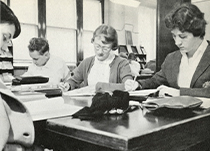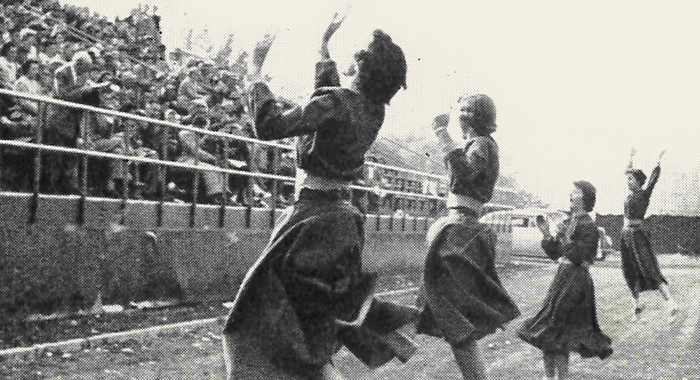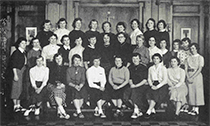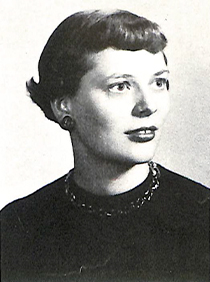The First Women of St. Norbert
It’s been 70 years since the first women formally admitted to St. Norbert as co-eds stepped onto campus to claim their place as part of the brand-new Class of 1956. They formed a very considerable minority at a school that had been men-only since its founding in 1898. In the ensuing years, a great deal has changed for the college, for the campus community and for the experience of women who, here in 2022, form 59 percent of the student body. We celebrate those pioneers who began it all.
The First Women of St. Norbert
The lone women’s bathroom on the first floor of Boyle Hall was a safe haven of sorts for a newly enrolled group of young, bright-eyed students. In between class periods, which included early Saturday mornings, 24 first-year female students found themselves bonding together in their not-so-typical hangout across from the library.
It was the place-to-be because there wasn’t really a space for them yet.
When St. Norbert College announced an official change to co-education in the early 1950s, these young women became the first of their kind. They blazed a trail for many other women and minority groups who would attend SNC in the decades after.
Getting to campus
The year was 1952, and getting to and from their daily classes was the first barrier these trailblazers needed to overcome. Since women couldn’t live on campus (the on-campus residence hall was men only), they journeyed back and forth every day. Those who were from areas further away had to find lodging within walking distance, typically from families willing to house college students.
Ann (Morneau) Hollenback ’56 lodged in a house nearby on Fourth Street. Since she hailed from Bear Creek, Wis., about 40 miles away, her only option was to find a place close to campus in order to attend. She wanted to go to a Catholic college after graduating from high school, but didn’t think SNC was a viable choice because the school was only accepting coeds from the local area at that time.
“My mother came and kind of twisted the arm of Father Dupont, who was the registrar,” says Hollenback. “Somehow she managed to get me in.”
Others carpooled to and from campus from their homes in the De Pere and Green Bay area.
Both Cathy (Schmitz) Jacobs ’56 and Nancy (Wahl) Riley ’56 had graduated from St. Joseph Academy in Green Bay and shared the same homeroom for four years. “My parents were retired so I could get the car more often,” says Jacobs. “Consequently, picking up three, four, five girls on the way, I was always late for class.
Luckily, it didn’t seem to bother her early-morning Norbertine professors.
After high school she wanted to teach and set her sights on the University of Wisconsin-Milwaukee for their well-known education department. There was some resistance to the idea from her father so she resigned to working full-time instead. As in Hollenback’s case, Jacobs’ mother got involved.
“My father didn’t believe that women should have to go to college,” she admits. “But when St. Norbert announced that they were going to be co-ed, my mother influenced my father to let me come.”
Riley was planning to attend the University of Wisconsin-Extension which had also just opened up their classrooms to women, but she switched gears when she was officially presented with a scholarship from the Green Bay Press-Gazette to attend St. Norbert.
First days of school
Looking back, those first days on campus were a mixed bag. All three ladies knew that some of their male classmates weren’t bothered by their arrival, while others were directly sharing their irritation. Those others included a few of the faculty. Some were known for their blatant dislike of women, too; but the male mood on campus was easy enough to handle overall. “The ones that were here prior to us when it was all boys had a different attitude than those that came in with us,” says Riley
 Jacobs recalls that one specific classmate was still voicing that disapproval at the class’s 50th reunion – all because the college had tightened its dress code. Men on campus could no longer wear more casual options like T-shirts. Meanwhile, the women were expected to always wear skirts. Hollenback was even called into the office for not wearing a skirt while exploring downtown De Pere.
Jacobs recalls that one specific classmate was still voicing that disapproval at the class’s 50th reunion – all because the college had tightened its dress code. Men on campus could no longer wear more casual options like T-shirts. Meanwhile, the women were expected to always wear skirts. Hollenback was even called into the office for not wearing a skirt while exploring downtown De Pere.
“I was seen wearing jeans,” she admits, a small, playful smile on her face.
The dress code was just one of the expectations put in place for students back in 1952. The dining areas were men-only in the beginning, so female students either ate at the snack bar in the Van Dyke Gym or at the off-campus houses where they were staying. Hollenback explained that radios had to be turned off at 9 p.m. in the dorms, and all students were expected to observe “quiet hours.”
The dean of women, Mary Lanigan, also kept a strict eye on her charges’ off-campus activities. “There were places where we would congregate in the evenings downtown, and it was very prohibited,” shares Jacobs. “Dean Lanigan and Father Cornell would walk the streets and peek in the windows to see who was there.”
Fun, games and academics
It wasn’t all super strict administrators, dress-code violations, or closed doors on campus, though. A “Ladies of St. Norbert” social group – LSN, of course, so dubbed Lambda Sigma Nu – was created in the women’s sophomore year. The Rev. Anselm M. Keefe, Class of 1916, ran a theatre group. He wrote and directed plays, performed on the third floor of Main Hall, that Hollenback remembers fondly.
“Father Keefe became my teaching mentor, too,” Hollenback says. “He was very supportive.”
Physical education classes were held in the Van Dyke Gym where the women could play basketball – even though it had to be by “girls’ rules,” which meant using only half the court. “Eventually, we got to do bowling with Father Jolicoeur,” says Riley. “He also coached boys’ tennis and he let me go out and hit with the team.”
With a minor in physical education, Riley had to take many of her classes with male students.
Many fraters – those men studying to be Norbertines – typically attended their classes in the abbey at the time. (This was the original priory on campus, now St. Joseph Hall. The new St. Norbert Abbey across the river would not be built until 1959.)
“The only time you ran into the fraters was in the library and you weren’t supposed to talk or look at them,” Riley says. “But most of them were neighborhood boys or guys we had gone to school with so you would sneak over to say hi anyway.”
As a senior, Hollenback needed to enroll in one more philosophy course, but the only session left was one reserved for fraters. It was originally going to be taught in the priory, but was moved to Boyle Hall so she could attend too.
Outside the classroom, the women coordinated and attended dances throughout the year, including at Homecoming, and demonstrated their school spirit at basketball and football games. A cheerleading group formed their sophomore year.
“We were in charge of ordering our own uniforms,” Riley emphasizes. “So many things we had to do on our own.”
“That first year of cheerleading, you talked me into it,” Jacobs laughs, looking pointedly at Riley. “I was horrible.”
That cheering also extended to Abbot Pennings’ birthday. The entire campus would gather in front of Old St. Joe’s to sing to him in person on his special day.
“‘You children are so good, you can have the day off,’ he would always say,” Hollenback remembers.
“That’s why we sang it!” chuckles Riley.
In the 70 years since
Hollenback, who ended up back at St. Norbert more than once since her undergraduate years, says the education she received there has influenced every year since. Under Keefe’s encouragement, she decided to attend UW-Madison to earn her master’s degree. Then, she was invited back to teach at SNC. Over the years, her teaching life also took her to UW-Green Bay, to St. Boniface in De Pere and to St. Joseph Academy in Green Bay, where she taught biology to high school and college students. In 1990, she joined Notre Dame Academy and remained there for 30 more years until she retired in 2020 after 60 years of teaching.
“I taught a lot using stories, like Father Keefe,” she says. “Years later, students would tell me ‘thanks for the stories.’”
While Hollenback bounced around, Jacobs stayed in place. After her student-teaching placement in Ashwaubenon, Wis., she remained at that school for another 34 years. During that time, she obtained her masters from Northern Michigan University and became closely connected to St. Norbert’s student-teacher program. “My husband, Bud, established a scholarship with the education department,” she shares. “Someone who completes their Sophomore Block placement in either elementary or secondary education receives a scholarship from us.”
Jacobs’ local involvement also extends to the Rawhide Boys Ranch where she helped establish the Bud Jacobs Award 24 years ago in alignment with the ranch’s Student of the Month program.
While both Hollenback and Jacobs stayed in Wisconsin, Riley would end up in Crystal Lake, Ill. She taught sixth graders and then switched to physical education for three years. After meeting her husband, she started a new position in Marion Central Academy’s P.E. program, but left early on to start a family, as was expected. As her five children grew, she returned to work with a position at the Crystal Lake Park District.
While the original 24 women in St. Norbert’s first co-ed intake enrolled in the fall of 1952, not all would seek degrees. Ten of the first-years who enrolled in 1952 graduated from the college in 1956. Six of the women had enrolled as upperclassmen with two in each grade level: Those junior and senior students graduated in 1954 and 1953, respectively.
• The first woman ever to graduate from SNC was Agnes Duckett Toonen ’41. (Her son Tony Toonen ’79 would attend in his turn.) At the time of Agnes’ death, she was the school’s oldest living alum.
• Through the 1940s and 1950s, Notre Dame, Dominican and Franciscan sisters completed their educations at St. Norbert, attending classes on campus during the summer.
• The first fully co-ed class enrolled in 1952.
• Lambda Sigma Nu (above left) hosted the college’s first mixed social function for students on Feb. 15, 1953. Some 50 students went to Legion Park ice rink and afterward enjoyed a hot lunch at 301 Marsh St. (This was the first time that male students had been allowed to visit the women’s lounge.)
• In 1955, women competed in an intramural sport – basketball – for the first time. The Pokey Dots took the title.
• Rosie (Olejniczak) Cuene ’56 was selected as the college’s first-ever Homecoming queen.
• Maureen Hogan ’55 (pictured) became the first woman to serve as a class officer when she was elected as treasurer for the freshman class in 1953.
• It seems likely that one W. Lambert, assistant in physical education, was the first female faculty member at SNC. By 1955, two others had joined her.
• Helga Schramm, first international woman student, studied at SNC in 1953. The Austrian was chosen as Queen of the Sweetheart Ball.
• Gertrude Bergstrom was SNC’s first woman trustee, serving on the board of governors 1954-66.
• Anna Schmitt was the first to be recognized with SNC’s Alma Mater Award, accepting the honor in 1957. All 11 of her sons graduated from SNC.
• Meg (Perkins) Vander Zanden was the first student from SNC to study abroad, enrolling at the University of Aix-en-Provence in France, in 1962.
• Joanne Burns ’54 was the first woman from St. Norbert to be listed in Who’s Who.
• Sandy Odorzynski (Economics, Emerita) was the first female faculty member to hold the rank of full professor, a position she attained in 1997.
FIRST-YEARS
Marian Baenen Smeester
Mary Jean Barrett Terry
Constance Sherman Belongia
Joan Bielinski Lennon
Mary Ann Cavanaugh Barger
Jo Ann Centen Blair
Dorothy Don Leoy
Donna Haanen
Maureen Hogan Neufeld
Donna Janssen De Broux
Delores Mintjal Westlund
Clara Ann Morneau Hollenback
Karen Murphy De Quardo
Rosalie Olejniczak Cuene
Janice Mateju Peot
Ruth Platten Huguet
Patricia Reinhart Britton
Shirley Rustlie Firehammer
Joan Schmitt Meyer
Catherine Schmitz Jacobs
Colleen Sullivan Hawley
Nancy Vande Walle Jocis
Mary Van Roy Mueller
Nancy C. Wahl Riley
SOPHOMORES
Helen Linsmier Lenss
Jean Peters
JUNIORS
Joanne Burns
Hazel Van Vonderen Duquaine
SENIORS
Evelyn Kroening Schrickel
Elsie “Peggy” Lang Teeters
June 30, 2022







 Female Firsts at SNC
Female Firsts at SNC





